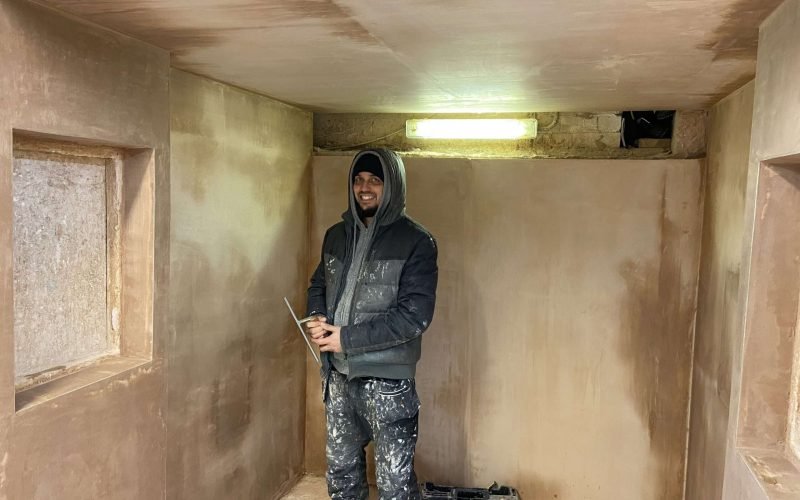Key Tips and Devices for Successful Gluing in your house Renovation Endeavors
Accomplishing a flawless plaster finish in your home enhancement tasks needs a blend of the right tools and proven techniques. Understanding the subtleties of mixing plaster and using it in thin layers can significantly influence the final outcome.
Vital Plastering Tools
The important tools include a variety of carries out designed to facilitate the smudging procedure efficiently and successfully. Secret elements include a hawk, which is a flat, square tool made use of to hold the plaster while applying it to surfaces.

Additionally, a mixing bucket is necessary for preparing plaster, ensuring the appropriate uniformity prior to application (Plastering). With each other, these crucial plastering devices make it possible for both specialists and DIY enthusiasts to achieve top notch results in their smudging projects.
Surface Area Prep Work Strategies
Effectively preparing the surface area prior to plastering is crucial for guaranteeing attachment and achieving a perfect coating. The primary step entails cleaning up the surface to get rid of any kind of dust, oil, or old paint that might prevent the plaster's capability to bond successfully. A thorough wash with an ideal cleansing solution is recommended, followed by allowing the surface and rinsing to completely dry completely.
Following, assess the surface for any kind of imperfections or cracks. These need to be full of an ideal filler compound and permitted to cure according to the manufacturer's guidelines. For porous surfaces, applying a primer is important to enhance and develop an uniform texture adhesion.
Additionally, it is important to ensure that the surface area is stable and structurally sound. Any loosened materials, such as flaking paint or damaged drywall, ought to be fixed or gotten rid of. Consider making use of a scratch coat to enhance hold. if functioning with masonry surfaces.
Combining Plaster Like a Pro

Making use of a clean mixing container, pour the water initially, after that progressively add the plaster powder while stirring continually - Plastering. This approach helps to avoid clumping and guarantees an even circulation of materials. A mechanical mixer can be beneficial, offering constant results and saving time. Go for a velvety, lump-free uniformity that allows for very easy spreading yet is thick enough to hold its shape without running.
Once combined, enable the plaster to rest for a few minutes to enable the gypsum crystals to hydrate fully. This pause boosts workability and reduces the risk of breaking throughout application. By adhering to these actions, you can mix plaster like a pro, setting the structure for an effective gluing job in your home improvement undertakings.
Application Approaches for Smooth Finishes
With the plaster combination prepared to the optimal uniformity, the next action involves choosing proper application approaches to achieve a smooth finish. This tool allows for a penalty, even web distribution of plaster throughout the surface area while minimizing trowel marks.
Begin by using a charitable amount of plaster to the surface using the trowel, guaranteeing it adheres well. When the first coat is used, utilize a sweeping activity to smooth the surface area, using even pressure.
For the last touches, a damp sponge can be used to refine the surface area further. Gently haze the plaster with water and delicately rub the surface area to attain a refined impact. Constantly remember to operate in small areas to preserve control over the application process, making certain a smooth, expert coating throughout your plastering job.
Typical Mistakes to Stay Clear Of
When beginning on a gluing job, avoiding typical blunders is vital for accomplishing a remarkable coating. Ensure that all dirt, oil, and loosened materials are gotten rid of before applying plaster.
One more usual mistake is applying plaster as well heavily. Thick layers can fracture as they dry out, compromising the integrity of the surface. Rather, select numerous thin layers, permitting each why not find out more coat to completely dry totally before applying the following.
Furthermore, bad blending techniques can cause irregular appearance and workability. Constantly follow the supplier's directions for mixing proportions and extensively mix the plaster to attain a consistent consistency.

Timing also plays an essential role; plaster needs to be applied while the substrate is damp to improve bond. Last but not least, prevent utilizing improper tools. Top quality trowels and floats can make a significant difference in achieving a smooth surface. By guiding clear of these common challenges, you can improve the top quality and longevity of your plastering work, resulting in an extra specialist cause your home improvement undertakings.
Final Thought
Efficient gluing requires a comprehensive understanding of essential devices and strategies. Proficiency of these aspects not only adds to the visual allure of an area yet also makes sure longevity and long life in plastering projects, making them essential to successful home enhancement undertakings.
A float is another vital tool, which helps in leveling the plaster and attaining a consistent surface area.

By complying with these actions, you can mix plaster like a professional, establishing the structure for a successful gluing project review in your home enhancement endeavors.
Gently mist the plaster with water and delicately massage the surface area to attain a polished effect.